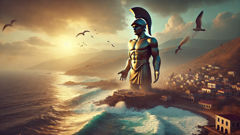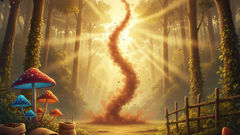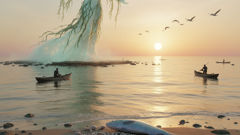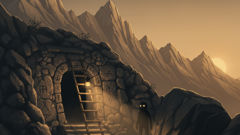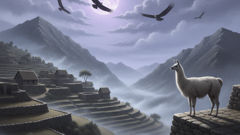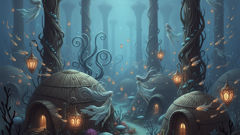Introduction
In the days when gods still walked close to mortals and the sea kept its own counsel, the island of Crete rose like a living amphora from the Aegean, its coastline rimmed with salt and rock, its plains threaded with olive groves and vineyards. From the workshops of Hephaestus in the volcanic throat of the world came a marvel not born of flesh but wound and hammered from bronze: Talos, a colossal automaton, stood taller than a house, joints riveted with the secrets of the forge, surfaces patterned with the impressions of hammers and tongs. He was a guardian in an age when kings were fewer than the capes that jutted into the sea, when traders and raiders alike traced the coastline, seeking the wealth of Minoan palaces and the soft corridor of harbors that dotted the island. They say Hephaestus cast him at the request of Zeus or of Minos—the stories shift like wind on water—yet the truth of his making matters less than the watch he kept: night after night Talos paced the headlands, a lantern of metal reflecting the moon, the gulls wheeling and crying about his great helmeted brow. Fishermen would tell of the way the bronze chimed like a bell when a wave struck his shins; children dared one another to run the length of his shadow at noon. He was promise and threat at once: protector of the island, curiosity to its poets, and a strange, immovable answer to the age’s anxieties about invasion and change. In the grooves of his shoulders, in the thickness of his calves, the islanders read the economy of safety, and in his single vein—rumored to hold ichor or a stream of molten life—lay the hinge upon which the fate of Crete would turn. This is a retelling of that watch: how Talos learned his island, how he battled those who came on dark bows, how loneliness and duty braided into the loom of myth, and how, in the end, a cunning human hand and a whisper of guile unspooled a guardian whose heart was bronze but whose story became as mutable and human as the salt on the shore.
Forged by Fire and Duty: The Making of Talos
They spoke of Hephaestus' smithy as if it were a throat of the world, a place where mountain and magma met in a chorus of sparks. In the telling, the god of fire and craft did not shape Talos from mere metal but from a purpose pressed into bronze with the same force he used to shape the thunderbolts of Zeus. The metal glowed in stages of thought; the hammer strikes were a language. To the smith, form and function were syllables of a covenant: Talos would be walking fortification, sentinel, and law in a time when islands were vulnerable to the shifting tides of men and fleets. Patina and nuance were born in the cooling—brass and tin alloyed to withstand salt and sun—while the joints were oiled with substances known only to those initiated into Hephaestus’ lesser mysteries. When finished, Talos did not rise all at once like a sleeping mountain: the first steps were guided by ritual—incense of laurel and myrrh, songs of the islanders, offerings poured into his hollow breast. Priests counted the numbers of his steps and marked them with stones, fathers took their sons to see him, and the king of Crete—Minos in some versions, or a council in others—made vows and treaties around that molten urn of a forge. Talos’ anatomy reads like a map of craft. His arms were hinged on bronze bearings, the palms patterned with reliefs that caught the sun; the knees contained coils and mechanisms that flexed like ropes; the neck swivelled with the careful cunning of a ship’s capstan. The workmanship was not merely brute; the surface featured engraved symbols, protective sigils, perhaps the maker’s mark—an open pair of tongs—testifying that art and protection had been braided. Yet for all its artistry, his most astonishing feature was a single sealed vein—a conduit of some living principle: an organ not of flesh but of molten necessity. At the ankle it entered the bronze body and ran like a spine, a line of liquid that reinforced movement and provided the animating spark. Scholars much later would argue if it was oil, molten metal, or a mythic ichor. For those who told the story while the sea still smelled of constant trade, the vein was talismanic—a moat of life that made Talos both machine and miracle. The presence of Talos changed Crete’s rhythms. Markets opened earlier; fishermen dared shores they once avoided. Ships slowed as they passed the headland where he stood, paying tribute with a wave or a tossed ribbon. Bands of raiders found their courage blunted against a sight they could not match: the slow, inexorable pivot of bronze as Talos turned his helmet to follow a prow. His steps were measured, not rushed; they reverberated through cliffs and harbor stone, sounding like a low drumbeat that came to mean the island’s protection. Yet in quiet moments, when the wind lay down and only the sheep’s bells answered the sea, the islanders discussed what it meant to place their safety in the care of an unblinking, unmoving giant. Children grew used to the glint of bronze on the horizon and built tales around his shadow—of his single vein that sang at night, of his sigh when the tide went out. These stories formed a living context around Talos: he was not merely a weapon or a statue but an axis around which Crete’s imaginations turned. We can trace the psychology of the island’s security to Talos’ very presence. In the world before professional navies and stone fortresses, a sentinel like Talos was both deterrent and symbol—a place where the community projected both confidence and fear. For leaders, Talos was a bargaining chip; for poets, he was a metaphor. In the long view, the automaton’s origin blends sacred making with pragmatic design. Whether Hephaestus himself struck the final blow or a guild of smiths followed a divine blueprint, the idea was the same: a thing brought into being to answer a problem. The problem—how to keep Crete safe—was addressed by creating a being that could endure the sea’s corrosions and the spear’s fury, that could stand on headlands for generations with only the occasional maintenance at hidden coves or under the gaze of the island’s craftsmen. That care would later reveal a human dimension rarely discussed: Talos needed tending, an act that created relationships between mortal hands and immortal metal. Priests performed rituals to cleanse salt from his joints; craftsmen scraped barnacle and polished his plates; young boys were apprenticed to run between his toes and learn the cadence of his watch. Those acts of maintenance humanized the giant, made him part of the island’s domestic life. When storms came and gulls rode the winds like ragged flags, Talos’ silhouette was a promise. When ships arrived with hostile intent, they found, instead of the easy plunder of an empty shore, a figure whose very existence complicated their plans. The forging of Talos was not just a technological answer to a strategic question; it was an island’s decision about identity and survival, a decision made in fire and cooled in the salt-laden breese, a decision whose consequences would ripple into myth.
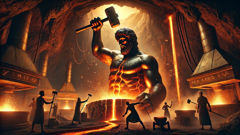
The Long Vigil: Talos and the Life of the Island
To live in Crete with Talos on the headlands was to learn new rhythms of security and ritual. The giant became a constant axis: fishermen timed their departures by the angle of his shoulders at dawn, shepherds judged the weather from the way gulls circled his helmet, and traders felt a peculiar relief as their hulls slipped into the harbor shadowed by bronze. Talos did not sleep in the human way; he stood, turned, and watched, and the island’s life bent around that pattern. Because of him, fewer watchtowers sprouted along the coast; because of him, the kings felt secure enough to pursue trade and art. In the palaces, artisans worked with the confidence of safety; frescoes flourished, bronze vessels were beaten into shapes of bulls and wreaths, and amphorae held oil and wine destined for far ports. Yet the presence of a mechanical guardian shaped more than commerce. It altered the conversations of the living. When a family gathered for bread and olives by lamplight, they spoke sometimes in the hush that filled the space after Talos’ steps. Mothers used his name as a talisman to hush the children—"Keep still, like Talos," they would say—and lovers spoke of him as a silent third at the edge of town, a being whose indifference allowed humans their frailties. Over years, tales accumulated. Sailors told of attacks averted by Talos’ sweep: a band of pirates whose ropes were thrown into the surf by a single swing of his arm, a brigantine whose mast was crushed beneath a heel of bronze, men who had to retreat and later claimed the island was cursed. But not all encounters were violent. Once a merchant ship was dismasted near a lee because of a sudden squall, and Talos crouched at the cliff like an enormous shepherd. The villagers rowed out to salvage what they could; the giant, when the sea ebbed, helped by nudging a tangled hull with his arm, not in mercy but in the automatic logic of his task: protect the shoreline. The islanders interpreted such acts as benevolent; priests inscribed hymns to him, and dedications were left at his feet. In time, the giant acquired ceremonies as vast as any old-world god’s. Each harvest included a small rite to clean his joints of brine; newlyweds mapped their vows against his shadow; the old left their last wishes to be spoken near the place where his foot met the cliff. Yet his vigil also brought inevitable friction. Some envied the security he provided; others feared the complacency his presence produced. A band of young men once challenged the sense that the giant carried moral weight; they staged mock raids to test their courage against the bronze and returned home humbled when the giant’s swing—though measured—was terrifying in its certainty. Leaders used him to justify harsh measures too: a warlord would claim that the island’s safety under Talos permitted retribution against dissenters or the expansion of territory. This duality—protector and instrument—complicated Crete’s civic life. Philosophers who later gathered by courtyard tables debated whether a protector that could be wielded by rulers was morally different from the defenders of a citizen militia. Talos was neutral to such arguments, his bronze indifferent; but the arc of his influence was plainly human. Over decades the smiths who tended him passed their skills to apprentices who spoke of the giant almost like a member of the guild. They polished him before festivals, replaced bolts and rivets, and sometimes poured aromatic oil down his seams to keep the metal from cracking in heat. There were rumors—faint, whispered—that the vein in Talos required rare substances to keep flowing, powdered resins brought across seas, a kind of maintenance that bound the island to trade routes and to the goodwill of distant partners. That need placed Crete in a wider web of exchange; Talos, the isolated guardian, tied the island to the commerce of oak and resin, to merchants who brought bronze and spices. This woven network of trade and ritual made the giant less a solitary artifact than the center of a living economy. But long vigils produce wear that goes beyond metal fatigue. With time Talos became an emblem caught between admiration and unease. Young poets composed laments imagining him as lonely, a single sentinel who watched while life thrummed elsewhere. Painters added small flourishes—a child tucked against his toe, a pair of lovers passing with hands clasped in his shadow—images that humanized him without diminishing his majesty. Travelers came from distant islands seeking to see the bronze wonder, and some recorded their impressions in itineraries that would one day inform historians. To outsiders he was both marvel and threat: marvel because of the ingenuity he represented, threat because a giant of bronze suggested a community able to weaponize craft beyond common reckoning. And so Crete grew used to being both admired and envied, nourished by a protector whose presence shaped trade, law, ritual, and imagination. The giant’s very constancy was a lesson: security changes the way a society moves, and the presence of a guardian—metallic, immovable—does not erase human complexity; instead, it reveals it in sharper relief.
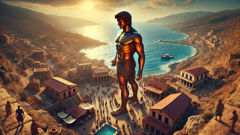
Betrayal and Dismantling: How the Bronze Giant Fell
Stories diverge on the moment Talos’ watch ended. One thread places cunning in human hands: the island welcomed a stranger, a craftsman or trickster who walked the streets, learned the rhythms, and watched the giant with an interest that seemed innocent. Another thread roots the end in divine caprice, a deception spun by jealous gods. In either telling the same fragile fact emerged: an opening, a vulnerability, and the unspooling of a watch that had once seemed immutable. The most persistent version involves a visiting sailor—sometimes named Medea in later retellings, sometimes an unnamed rogue—who came aboard a merchant vessel and promised wealth in exchange for harbor. They say she carried with her a secret: a small tool, a heated nail, or a whisper of herb that dissolved seals. While the island celebrated a festival and drums drowned nightly breakers, she climbed the headland at dusk, when Talos’ silhouette softened. The giant turned his helmet to follow the shore, and she crept under the bronze to the vein running at his ankle. There, in the seam, she found the plug that sealed the flow of the molten essence. In a breath—literal in the telling, metaphorical in the myth—she removed the plug, and the vein bled out a bright, slow stream. As the molten life left, Talos staggered like a statue losing its center. The first time his hip buckled, sailors far out at sea thought an earthquake had gripped the rock; birds scattered; the ocean hissed against the shore like a thing suddenly alive with gossip. Talos tried to lift his foot but the world went quiet with the possibility of change. Priests ran, craftsmen cursed, and the islanders gathered to see what happened to the guardian that had never faltered. In other versions it was not a stealthy hand but a moral choice that unmade him: an envoy from the mainland offered Crete riches in exchange for access to the giant; leaders divided, some fearful of the price of absolute independence. Those who sought cunning to dislodge the giant did not always appear as villains in the narrative; they sometimes appeared as agents of a necessary change, an argument that no island should be defended by a single bulwark whose power could be monopolized. Yet the core outcome was the same: the flow that animated Talos slowed and then ceased. His foot, once a metronome for fishermen’s steps, crumpled. Bronze groaned not just in metal but in the weight of a world losing an axis. The fall was not dramatically cinematic in the way epics often prefer; rather, it was intimate and tragic. Men who had polished his plates wept with an odd tenderness, as if mourning a living thing they had known only in part. Children lost a reference for games; sailors felt a fresh vulnerability when they passed the headland. Titans and gods exchanged complicit glances in the margins of the myth, the narratives showing sympathy, schadenfreude, or inscrutable detachment depending on the teller. But the end of Talos raised questions as urgent as his making had answered. Who owns security? Can a people accept that their safety is outsourced to a single being, no matter how reliable? When the plug was removed, it was not merely metal that emptied: it was the community’s illusion of impregnable protection. In the aftermath new structures rose: watchtowers, militias trained by veterans, and a redoubling of civic engagement in defense. In the cultural memory of Crete, the loss of Talos did not mark only ruin but a reconfiguration. Artists carved reliefs commemorating the giant’s stance, poets wrote elegies addressing his empty helmet, and orators debated in agora whether the future belonged to those who trusted in artifacts or to those prepared to physically answer threats themselves. Economically, the island adapted. Trade routes that had skirted hidden coves now required armed convoys; craftsmen who once serviced Talos pivoted to weapons, hull repairs, and fortifications. Part of the myth’s force is its capacity to capture this pivot from technological singularity to distributed resilience. But tragedy lingered as well. One enduring image is that of a child dragging a bronze coin to Talos’ fallen hand, offering a crude apology. Another is of a smith who, in his last act, hammered the automaton into smaller objects—swords, ploughshares, and ornaments—trying to salvage usefulness from the ruin. Some versions say Talos’ single vein was returned to the earth as a river of metal that, when cooled, became the island’s secret ore deposits—an origin story for future artisans. Others claim the vein was poured into the sea where it became the source of a natural shimmer visible on certain moonlit nights. Myth and reality braid here: the loss of Talos is both a historical pivot and a moral lesson. It teaches that reliance on a single guardian carries risks and that the dismantling of such a guardian can catalyze societal transformation. Those who mourned did not only lament what was gone; they argued and acted to make sure what remained—people and place—could stand on its own. Over the centuries, the silhouette of Talos persisted in frescoes and in the rhetoric of states that admired Crete’s capacity to reinvent. When scholars later sought to reconcile the story with archaeological evidence, they found bronze fragments, ritual deposits, and coastal structures consistent with intensified defense measures after the period in which a giant guardian might have plausibly existed. Whether Talos was wholly divine, half-mechanical miracle, or a sophisticated construct of human craft, his story mattered less as a literal account and more as a cultural fulcrum. He shaped how a people imagined their relation to power, to safety, and to the sea that both sustained and threatened them. In the end, the giant’s dismantling was not merely an end but the beginning of a new chapter—one where Crete learned to stand differently in a world of shifting fleets and shifting fortunes.
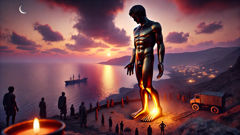
Conclusion
Talos survives in our stories as a complex emblem: guardian and instrument, wonder and warning. The legend insists on contrasts—metal and ritual, automation and care, permanence and fragility—so that each telling becomes a mirror held up to its own time. For Crete, the giant’s presence shaped trade, law, and imagination; his removal reshaped courage and self-reliance. In the hush after the fall, the island learned the cost of depending on single solutions and the value of weaving protection into the fabric of community life. Poets composed laments that were also calls to action; smiths who once greased seams re-forged a civic identity in which many hands answered the call of vigilance. Generations afterward, travelers on the Aegean still point to the headland and imagine the silhouette; children chase one another in the bronze shadow without quite knowing the political lessons embedded in their game. Talos’ myth endures because it speaks to a simple, stubborn truth: guardians can be crafted, but the world asks more than guardianship alone. It asks stewardship, adaptation, and the willingness of communities to learn from loss. In the golden wash of sunset, when the sea remembers every passing ship, the silhouette of a bronze giant will always hold a story—one of craft and courage, of betrayal and renewal, and of an island that kept living long after the bronze stopped walking.

